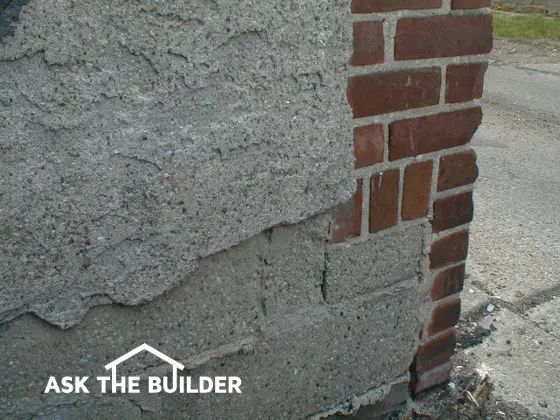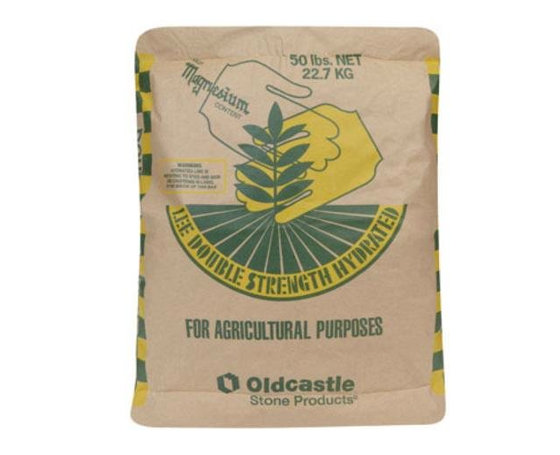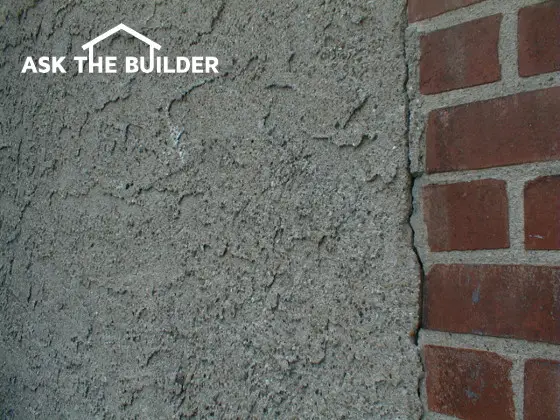Cement Stucco Foundation Finish

You can see where the stucco is partially covering the foundation. I think that dirt used to come up to the stucco and was removed years later to build the parking lot. ©2017 Tim Carter
Cement Stucco Foundation TIPS
- Use traditional cement stucco - it lasts
- Mix Portland cement, medium sand and lime
- WATCH stucco video below
- Use secret cement paint on existing concrete block / concrete
- CLICK HERE to Get Tim's FREE & FUNNY Newsletter
DEAR TIM: My home has two types of foundation: concrete block and poured concrete. They look horrible because of the different colors and textures.
How can I make them look uniform? I've seen other homes where the foundations have been covered with a stucco material. Is it too late to do this?
How was the stucco successfully applied to my neighbors' foundations? Lori B., Bright, IN
DEAR LORI: I couldn't agree more with you with respect to the contrasting colors and textures of concrete block vs. poured concrete.
Concrete Block Lines
There's simply something about the horizontal and vertical lines in the concrete block that clashes with the monolithic appearance of poured concrete. Making the two different foundations appear as if they are one is going to be fairly easy.
Cement Stucco = The Solution
You're going to cover the poured concrete and the concrete block with a thin layer of cement stucco. Masonry walls have been stuccoed for thousands of years and some still retain their stucco. Visit the Middle East and ancient cities in Europe and you'll see stucco that's thousands of years old. When installed correctly, it lasts because stucco is nothing more than a thin layer of artificial rock.
Free & Fast Bids
CLICK HERE to get FREE & FAST BIDS from local stucco contractors. Many also do plastering.
Sand, Cement & Hydrated Lime
High quality ingredients to make stucco are probably close at hand. Visit a building supply material business or a brick dealer and you should find bags of Portland cement, hydrated lime and different sands. Hydrated lime can also be ordered online and delivered to your home.

This is great hydrated lime. It's label for use on farms, but believe me it's GREAT to use for brick, stone mortars and whitewash. CLICK THE PHOTO OF THE BAG NOW TO HAVE THIS DELIVERED TO YOUR HOME IN DAYS.
The Portland cement made today when mixed with clean sand and a little hydrated lime will produce a stucco that's easy to apply. It's like spreading margarine on toast.
Low Cost
The best part is the cost: You can probably purchase the needed materials for the entire job for less than $100.00. That's a bargain when you think about the longevity of the finished product.
Clean Foundation First
The first thing you need to do is clean the foundation surfaces. This is one of the few instances where I advocate the use of a pressure washer.
Often rainfall causes dirt and silt to splash up onto a foundation. If you live in an area with clay soil, very fine clay silts can get deeply embedded in the pores of both the poured concrete and especially the concrete block. Pressure washers quickly and efficiently remove this silt.
Garden Hose Is No Good
Squirting the dirty masonry with a regular garden hose and a nozzle will not remove all of the dirt. A stiff scrub brush with soap will work, but that method involves considerable work. Once you have cleaned the walls, rinse them with clear water making sure they are perfectly clean.
Stucco Overview Video
This is a great video that shows you the stucco process on concrete block.
Time To Test
Next I suggest you buy one or two pieces of one-half inch thick cement board. You're going to need these to build a small test wall where you discover how to install the stucco. You don't want to make a mistake on your house and then have to chip it off.
Cement board typically comes with one side slightly rough and one side smooth.
Tack this cement board with the rough side facing out to an existing wall surface so that it does not flex. If you have to build a small temporary wood stud wall, do so. This surface is going to be your stucco simulator practice area.
CLICK HERE to get FREE & FAST BIDS from local stucco contractors. Many also do plastering.
Mix The Stucco
Mixing stucco is easy. Here's a recipe that's worked well for me:
- 3 parts medium sand
- 1 part Portland cement
- 1/2 part hydrated lime
Blend Before Water
Mix the dry or damp sand with the cement and lime until you have a uniform color and texture. It's now time to slowly add clean water to the mix. Blend the water, sand, cement and lime until the final texture and consistency resembles bricklaying mortar or a standard applesauce that's not runny.
When the correct amount of water is added, the stucco mix can be formed into a ball that is fairly plastic and will hold its shape if set on a flat surface.

The stucco has a great texture. My guess it is at least 80 years old, maybe older. ©2017 Tim Carter
Secret Cement Paint
The next step is to mix some cement paint. This is the most critical aspect of the application of the stucco.
The cement paint is made by mixing pure water with some Portland cement powder. Mix enough water so the powdered cement turns into a slurry that resembles paint.
Mist the cement board with a little water to get it damp, brush on some cement paint and immediately apply some stucco. Don't allow the cement paint to dry before it's covered with stucco.
Thin Layer
The stucco thickness should not exceed one-quarter inch. Use a regular steel trowel to apply it with arcing strokes.
The stucco should magically stick to the cement board without falling off. If it does fall off, the stucco mixture may be too dry. The hydrated lime in the mix makes the stucco sticky and improves the workability of it.
Infinite Designs
Now comes the fun part. There are an infinite number of designs, techniques, tools and textures you can create.
For example, you can use a stiff brush and stipple the stucco. You draw a brush across the stucco to create random brushed texture.
The steel trowel can be dabbed randomly into the stucco to create a different texture. Small angular colored stones can be cast into the wet stucco. The only thing holding you back is your imagination.
Stand Back
Be sure to stand back 20 or 30 feet to look at the practice stucco simulation. This is what people will see from the road or your yard. Looking at the stucco up close will give you a false impression of the real look you will see once the job is complete.
Cool Overcast Days
The best time to install stucco, in my opinion, is cool to slightly warm weather. Working on an overcast day with little or no threat of rain is best.
Sunny, hot and breezy days are the worst as the stucco can dry too quickly. You want the stucco to dry slowly.
Follow The Sun
Try to follow the sun. This means work on a wall surface that has just entered the shade and the sun will not strike the wall until the next day.
Keep It Damp
Once the stucco has hardened to the touch, keep it slightly damp with very light misting of water. If possible, try to do this for two to three days.
This added water allows the cement in the stucco to cure allowing millions of microscopic crystals to grow into the poured concrete and concrete block surfaces. These crystals are the glue that permanently bond the stucco to the masonry surfaces.
CLICK HERE to get FREE & FAST BIDS from local stucco contractors. Many also do plastering.
3 Responses to Cement Stucco Foundation Finish